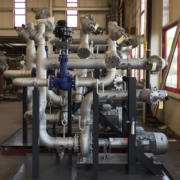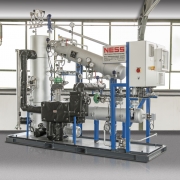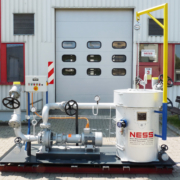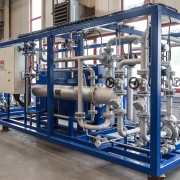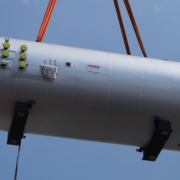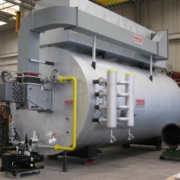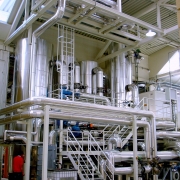Efficiency, a completely unambiguous term – OR NOT?

Achim Schwarz
The first part of our interview series on hydrogen as an energy source, in which Sales Engineer Achim Schwarz discussed a fuel cell vehicle in the Ness fleet was met with great resonance.
In this second part, he explains that you have to take a close look when it comes to efficiency considerations. He also gives us an insight into the life cycle emissions of hydrogen when used as a road transport fuel. This much can be revealed: It’s worth reading to the end!
Achim, especially when it comes to the production and use of hydrogen, there is a lot of talk about efficiency. When you see statements that hydrogen as an energy source performs poorly in this respect, you would think that this term is clearly defined, wouldn’t you?
Let’s cut it short: It’s absolutely not! Being a power engineer, it is always amazing to me to see how even people who should do better – such as university professors in the field of energy – do not mention the definitions chosen in their statements. In other cases, however, this is certainly also based on a lack of knowledge.
Give us an example of what makes the difference in the definitions!
I’ll start with the energy content of fuels that contain hydrogen atoms, which release water during their oxidative conversion. You can, for example, leave the water formed during combustion in the gaseous state , in which case the energy content is called the lower heating value. However, if it is brought to the liquid state and the additional heat released during condensation is used, this is referred to as the higher heating value [instead of heating value, the term calorific value is also common].
The more hydrogen a fuel contains, the greater the difference in energy content. If, for example, the difference for natural gas (four out of five atoms in its main component, methane, are hydrogen atoms) is around 10%, the difference for pure hydrogen is ca. 18% (lower heating value 33.3 kWh/kg, higher heating value 39.4 kWh/kg). A considerable difference!
And how is this point handled in practice?
The efficiency of heating appliances is usually specified in relation to the lower heating value of the fuel, also for historical reasons, since the additional condensation heat was hardly usable in the past. In building heating systems, however, condensing boilers are commonplace; when used correctly, they can actually utilize this “additional energy”. In the case of natural gas condensing boilers, this fact leads – at low heating circuit temperatures – to efficiency figures of 109%, for example.
From a marketing point of view, this is a great way of glossing over things, but from a physical point of view, of course, it’s nonsense.
Personally, I would therefore always prefer to use the higher heating value as the reference. The additional energy is undoubtedly contained in the fuel and can also be used in suitable applications. This is the reason why natural gas suppliers generally bill according to the higher heating value. But there is another reason, which I would like to explain below.
But would you like to give another similar example? Are there any other reasons?
When generating electricity, often only the electrical efficiency is considered, i.e. what percentage of the chemical energy bound in the fuel can I subsequently use as electrical energy (in the case of hydrogen production using electrolysis, the reverse applies).
However, the fact is that both processes also generate waste heat. Of course, this can be released into the environment without being used , but the idea that this is the only possible way should really only occur to absolute laymen. Combined heat and power generation has been around for a very long time in the energy supply sector and waste heat is also increasingly being used in electrolysis plants whenever it makes sense to do so.
With this in mind, how do you rate two fundamental technologies in the hydrogen field, namely fuel cells and electrolysis?
I would like to explain this using the mobility sector as an example, simply because almost everyone is familiar with this use case and many statements about it are particularly sensational.
Let’s start with the fuel cell, as in my view this is the major sticking point. In the case of fuel cells (as for electricity generation in general), the efficiency is usually stated in relation to the lower heating value of the fuel, as this approach naturally results in a higher and therefore more pleasant value! Modern low-temperature PEM fuel cells, which are basically the sole technology used in vehicles, achieve peak electrical stack efficiencies of approx. 67%. Only the pure fuel cell stack is considered in this value; if the auxiliary consumers – such as air supply – are also taken into account, this value drops by a few percentage points.
To be clear, this is a phenomenally good value from a technical point of view, especially in light of the fact that it is already achieved in the output class of a few kilowatts. The most modern combined cycle power plants, which can achieve similar values, have an output at least in the mid three-digit megawatt range!
If we now convert this to the higher heating value of hydrogen, then – with suitable dimensioning and effective hybridization in the vehicle – this results in an electrical system efficiency of around 50%. Some people may consider this approach to be somewhat “unfair”, as fuel cells can hardly use the additional condensation energy to generate electricity, probably not even in theory. But as I said, I will go into why I think the reference to the higher heating value is called for.
Could you please give us a more precise classification of this 50% value? Does this figure alone mean the death knell for this technology?
From my point of view, this is by no means the case. Just take conventional combustion engines as a comparison, which achieve significantly lower peak values, even more so on average!
Of course, different applications are also more or less ideal. Take, for example, a car that is driving on the motorway at summer temperature. It then needs a considerable amount of electrical power, but cannot use the waste heat and has to release it into the environment.
On the other hand, let’s consider a city bus that is used at winter temperature. In slow city traffic, it only needs moderate average electrical power, but also significant thermal power to heat the interior.
So you can see that in the second case, the fuel cell is an almost ideal energy source! The first case, on the other hand, makes it clear that the significant efficiency increase of fuel cells – as difficult as it may be for technical reasons – represents the “holy grail” that can decisively improve their economic viability in many fields of application.
Well, now to electrolysis. Is this the reason why you find the reference to the higher heating value useful?
Yes, exactly! In this case, the efficiency is usually based on the higher heating value, and this time not just to yield a more attractive value, but in my view quite rightly so. The reason is as follows: In order to be able to draw up the energy balance of an electrolysis plant, you have to determine how much electrical energy flows into the system on the one hand and how much energy leaves the system in the form of hydrogen and waste heat on the other.
If I were not to assign the higher heating value to the hydrogen produced, but only the lower heating value, then the energy balance would simply not work! It would then appear that more energy flows into the system than flows out, which is not possible due to the physical principle of energy conservation.
Now one could argue that this argument is irrelevant if hydrogen is produced from natural gas by steam reforming or methane pyrolysis, for example. However, since a steadily increasing proportion of the hydrogen used worldwide is produced by electrolysis, I believe that the reference to the higher heating value is correct and necessary.
Interesting point of view! Where does electrolysis stand in terms of efficiency and how can its waste heat be used?
In my view, we need to distinguish between two cases here: The situation today and the situation in the near future.
Currently, commercially available technologies such as alkaline or PEM electrolysis already achieve “chemical” system efficiencies of up to 75% (in relation to the higher heating value of the hydrogen produced). How can the waste heat generated be used? It is already being fed into district heating networks. Incidentally, I don’t see the significantly lower heating requirement of modern buildings as a disadvantage, because an unchanged warm water requirement also has to be covered – so I can supply more modern buildings and have a higher annual average coverage share from the electrolysis waste heat (assuming that the waste heat is generated relatively evenly throughout the year).
But even if I have few buildings near the electrolysis plant and therefore a district heating network makes no sense, there are still possible uses. Let’s take the case of road traffic again and consider, for example, a large service station at a favorable location in the road network (near a motorway junction/triangle or near a larger city). If a hydrogen fuel station with local electrolysis is built there, it doesn’t take much imagination to realize that there is considerable warm water demand for the kitchens, sanitary facilities for transit passengers and truck drivers staying overnight or even for car wash facilities.
So in your opinion, the issue of energy efficiency is no longer a stumbling block on the hydrogen production side? And what does that look like in the near future?
The situation gets even better! Various manufacturers have managed to raise efficiency into the 80 – 90% range by optimizing known principles (alkaline and AEM). They have already started series production of corresponding stacks or are about to do so.
With clever ideas or somewhat more revolutionary approaches, others such as Hysata or H2gen have already proven that system efficiency values of 95% are also possible, and here we should see commercial products on the market in the second half of the decade. So you can see that with such systems, there is less and less waste heat available that needs to be “collected” and used sensibly!
And now to the promised insight into a life cycle analysis using the example of road traffic: Why is it so important to consider the entire product life cycle and what are the findings on this point?
It’s quite simple: Because the energy required in operation is by no means everything; even for the manufacture of a product, often considerable amounts of energy are required. These requirements arise at different times, different energy sources are used and these then cause higher or lower (greenhouse gas) emissions.
In 2021, “The International Council on Clean Transportation” considered these points for passenger cars in a remarkable study. For those who are not familiar with the ICCT: It is no less than the organization that uncovered the VW diesel scandal in 2015.
It considers the life cycle emissions of passenger cars (mid-size cars and SUVs) with various drivetrains that are produced in the most important global markets in 2021 and 2030, are placed on the market and operated for 14 – 17 years with typical mileages (global averages are also calculated). Various generation scenarios are also considered for the respective energy source, e.g. for electricity the grid mix over the useful life or purely renewable, for hydrogen e.g. production from natural gas with or without CCS (Carbon Capture and Storage) as well as production by electrolysis with the electricity grid mix or purely renewable.
At first glance, some scenarios might seem less favorable for fuel cell vehicles than for battery electric vehicles. For example, if one assumes hydrogen production from natural gas without CCS over the entire service life (not that I personally think CCS is a savior!) and compares this with direct use of electricity from the grid mix.
However, the “ideal end state” (both hydrogen production and operation of battery-electric cars with purely renewable electricity) shows that there is not much difference! (I will come back to why I do not see 20 – 35% higher values as decisive).
In addition, consider the following: Hydrogen can be stored stationary, on a large scale and even more so seasonally with considerably less effort (e.g. like natural gas in salt caverns) than electricity. So unless we perfectly manage to charge battery electric vehicles whenever there is a lot of renewable electricity in the grid (we will address this issue in the next part of the series), the electricity required for this will be less “green” on average than that used to produce hydrogen. This fact therefore favors hydrogen as an energy source!
And even this very good study contains further assumptions which, in my view, make battery electric vehicles look a bit too advantageous:
• An electrolysis efficiency (the reference must be to the higher heating value) of – on avergae – only 70% on average is assumed (no credit for waste heat utilization) and
• with regard to the emissions generated during the production of the energy storage system, for example, the 5 kg hydrogen tank system of the Mirai 1 is compared with a battery of only 45 kWh capacity for Europe and the year 2021! Even if the latter value is set 20% higher for the year 2030: Anyone who has read Part 1 of this interview series knows that this is still not an adequate comparison.
Ok, this probably makes it clear to most readers why you consider many statements on the topics of energy efficiency and greenhouse gas emissions to be very bold and too abbreviated.
But now to your previous statement: Even if you don’t look so closely and – for the ideal end state (use of purely renewable electricity) – take 20 – 35% higher life cycle emissions of a fuel cell vehicle compared to a battery electric vehicle for granted: As an engineer at NESS, you usually try to get the last percent out of it. Isn’t that contradictory?
Well, in this context it might seem so! But I take a slightly broader perspective here. For one thing, we have relatively few raw materials available here in Europe that are needed to produce batteries for vehicles. And in recent years, we unfortunately had to realize how painful dependencies can be. Alternative cell chemistries can alleviate this problem considerably, but in some cases they have other disadvantages.
And as always: Everyone forges his own destiny! What I mean by this is that even the choice of vehicle class or personal behavior can make a considerable difference. For example, do I drive a SUV with 2.5 tonnes of empty weight and poor aerodynamics or a noticeably lighter and more streamlined mid-size car? And do I drive absolutely every route by car or do I sometimes also take the bike, bus or train?
Everyone actually has complete freedom of choice on these points. Then however, in view of such a wide range of possible environmental impacts due to a variety of factors, I personally consider it inappropriate and unnecessary to exclude a drivetrain technology – especially a fairly efficient one like the hydrogen fuel cell. In my opinion, anyone who wants to declare war on inefficient technologies should choose liquid e-fuels, which are used in non-hybridized combustion engines, as their target. The hydrogen fuel cell certainly doesn’t deserve that fate!
That’s all well and good, but now please explain the point of it all: Why have you dealt with the topic so intensively ? Apart from business trips, NESS has nothing to do with road traffic!
Apart from my personal interest, this was basically an interesting exercise and an example of how we also proceed in our core business: At NESS, we don’t just repeat widespread statements, but instead check exactly: What is the situation actually like? Does what is regularly propagated really always make sense? Can’t another approach also deliver good results?
Finding the really best solution for our customers, even if it is perhaps something completely different than what they initially imagined, is what we strive for in our daily work!
And even regarding the statement that, apart from business trips, we have nothing to do with road traffic, I would disagree. The reason is logistics, which is of fundamental importance to our business: We have a lot of commercial vehicle traffic every day, with everything from vans that deliver and collect parcels to heavy haul semi trailers that deliver parts for the largest of our systems or transport them to the customer in their finished state.
Here, too, I would personally like to see more and more of these transports being handled in a more environmentally friendly way!
What topics can our readers expect to be discussed in the next part of this interview series about hydrogen?
After a brief excursion on battery technology, I will look at some of the broader systemic aspects of energy storage and then address the question of which sectors should preferentially use scarce green hydrogen!
Well, then we’re already very excited!








